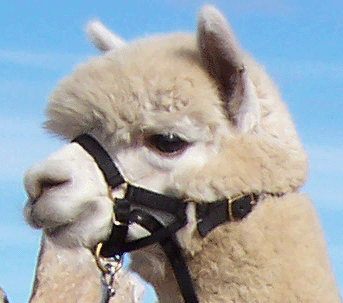|
With time, a patient approach and a correctly fitting halter most alpacas can be halter trained to lead, with a minimum of fuss.
Firstly, the halter design and fitting is of utmost importance. There are many different halters available on the market and some are far better than others. The halter should be of sufficient size and designed so that it fits high on the bony part of the alpaca's nose just in front of the eyes. This is to avoid pressure on the cartilage and soft tissue part of the nose which can lead to animal distress and
behavioural problems. The strap around the back of the alpacas head should fit around the back of the head, behind the ears and not be able to slip down to the back of the neck. A fixed lead ring under the alpacas jaw is recommended to provide a safe, secure place to attach a lead that will not slip or constrict the noseband, as can happen with a moveable lead ring on halter that has overlapping straps under the jaw. The diagram below shows a correctly fitting halter.
 Alpacas may be halter trained from a few months old, however, I have found the best age is about 4 to 8 months, when weaning or soon after. Use a small area, approximately 3 metres in diameter and preferably round or without 90 degree corners that can make the alpaca feel trapped. Halter training starts with making the alpaca feel safe with you in close proximity. Alpacas may be halter trained from a few months old, however, I have found the best age is about 4 to 8 months, when weaning or soon after. Use a small area, approximately 3 metres in diameter and preferably round or without 90 degree corners that can make the alpaca feel trapped. Halter training starts with making the alpaca feel safe with you in close proximity.
Firstly, try walking up close to the alpaca to maintain a close presence without touching the animal. With the alpaca calm and stationary, back off, giving the animal space again. This will need to be done repeatedly to gain the alpaca's confidence, and make it feel safe with you in close proximity. When successfully completed a number of times, patiently walk up to the alpaca in a non threatening way until you get close enough to hold it. Holding the alpaca firmly, you may like to rub lightly behind its ears. While the alpaca is calm, simply let it go and move back giving it space. This step can be repeated a number of times to gain the alpacas confidence and trust. However you should be careful not to let an alpaca go if it is struggling or it will assume this is how to get free and start repeating the
behaviour.
An underlying principle of this approach is to show the animal that it is safe to be handled, but, you are still in charge, and the one that decides when to let the alpaca go again.
After gaining the animals trust you may fit the halter, without a lead, and keep repeating previous steps. After a while the alpaca should become used to the halter and it will be time to try a lead. This is another critical stage and does require patience so that the alpaca learns to follows freely and doesn't learn to fight against you and pull away.
Start by attaching a long lead to give the alpaca some space. If an animal rears up it can be pulled down sideways so that it looses its balance and feels unstable while rearing up. This should be done in a controlled manner, without undue force that could injure the alpaca. When the alpaca is comfortable standing on a lead you may gently apply a small amount of pressure in a, 45 degrees off forward direction. If pulling straight forward the alpaca may dig in its toes and pull backwards. However, by applying pressure at an angle the alpaca should take a small step towards you to maintain balance. After the alpaca takes a step, it should relieve the pressure on the lead, allowing you to plan the animal's next step. If the alpaca starts to lean back, try moving around so that you are able to apply pressure at the other 45 degree angle. After some time, and small steps to begin with, you should be able to lead the alpaca continuously.
For show ring purposes, it is good to teach the alpaca to lead on your right. However, when an alpaca is totally comfortable on a lead they will lead singly, in groups, and on either side.
|